Comparison of Exergy and Advanced Exergy Analysis in Three Different Organic Rankine Cycles
Abstract
1. Introduction
2. Description of Systems
3. Energy and Exergy Analysis
3.1. Energy and Conventional Exergy Analysis
3.2. Advanced Exergy Analysis
3.2.1. Exogenous/Endogenous Exergy Destruction
3.2.2. Avoidable/Unavoidable Exergy Destruction
3.2.3. Combination of Splitting
4. Simulation, Results and Discussion
4.1. Model Validation
4.2. Conventional and Advanced Exergy Analysis
5. Conclusions
- According to the conventional exergy analysis, the highest exergy destruction was obtained in the evaporator for BORC, and for SRORC and DRORC, the maximum exergy destruction belongs to the turbine. Additionally, results of the conventional exergy analysis show that the condenser in three cycles is the third important component that should be noticed in designing. The exergy destruction rate for pumps may be neglected.
- The advanced exergy analysis showed that the exogenous exergy destruction rate is greater than the endogenous exergy destruction rate, except the evaporator, for BORC. However, in SRORC, the endogenous exergy rate of loss is higher than the exogenous part, except for the condenser. This indicates the greater share of the exergy destruction rate because of the internal irreversibilities in the component itself compared with BORC. Avoidable rate of exergy destruction in BORC, SRORC and DRORC are about 78%, 74% and 55% of the total destruction rate, respectively. Among the existing components, the condenser has the maximum value of exogenous exergy destruction rate, which can be reduced by the modification of other components.
- The endogenous/avoidable exergy destruction was identified as an important part of the destruction. Thirty-one percent, forty-seven percent and forty-five percent of the total exergy destruction rate in BORC, SRORC and DRORC placed in this part, respectively, can be reduced by improving the efficiency of the components.
- By the advanced exergy analysis, unlike the conventional exergy analysis, the preference of improvement should be given to turbines, evaporators, condensers and feed-water heaters, respectively. Additionally, regenerative cycles have high potentials to reduce their irreversibilities compared with basic systems.
Author Contributions
Funding
Conflicts of Interest
Nomenclature
| parameter | define |
| ORCs | Organic Rankin cycles |
| BORC | Basic organic Rankin cycles |
| SRORC | Single regeneration organic Rankin cycles |
| DRORC | Double regeneration organic Rankin cycles |
| M | Mass flow rate |
| E | exergy |
| Eph | physical exergy |
| Ech | Chemical exergy |
| energy efficiency | |
| ε | exergy efficiency |
| exergy of fuel | |
| exergy of product | |
| exergy destruction | |
| exergy loss ratio with the total exergy destruction | |
| exergy of fuel with the total exergy destruction | |
| avoidable exergy destruction | |
| endogenous exergy destruction | |
| exogenous exergy destruction | |
| unavoidable exergy destruction | |
| unavoidable endogenous exergy destruction | |
| avoidable endogenous exergy destruction | |
| avoidable exogenous exergy destruction |
References
- Yamamoto, T.; Furuhata, T.; Arai, N.; Mori, K. Design and testing of the organic Rankine cycle. Energy 2001, 26, 239–251. [Google Scholar] [CrossRef]
- Bao, J.; Zhao, L. A review of working fluid and expander selections for Organic Rankine Cycle. Renew. Sustain. Energy Rev. 2013, 24, 325–342. [Google Scholar] [CrossRef]
- Lecompte, S.; Huisseune, H.; Van Den Broek, M.; Vanslambrouck, B.; De Paepe, M. Review of organic Rankine cycle (ORC) architectures for waste heat recovery. Renew. Sustain. Energy Rev. 2015, 47, 448–461. [Google Scholar] [CrossRef]
- Zhang, S.J.; Wang, H.X.; Guo, T. Performance comparison and parametric optimization of subcritical organic Rankine cycle (ORC) and transcritical power cycle system for low-temperature geothermal power generation. Appl. Energy 2011, 88, 2740–2754. [Google Scholar]
- Li, J.; Pei, G.; Ji, J. Optimization of low temperature solar thermal electric generation with organic Rankine cycle in different areas. Appl. Energy 2010, 87, 3355–3365. [Google Scholar]
- Davarpanah, A. Feasible analysis of reusing flowback produced water in the operational performances of oil reservoirs. Environ. Sci. Pollut. Res. 2018, 25, 35387–35395. [Google Scholar] [CrossRef]
- Davarpanah, A.; Mirshekari, B. Experimental study of CO2 solubility on the oil recovery enhancement of heavy oil reservoirs. J. Therm. Anal. Calorim. 2019. [Google Scholar] [CrossRef]
- Davarpanah, A.; Mirshekari, B. Experimental Investigation and Mathematical Modeling of Gas Diffusivity by Carbon Dioxide and Methane Kinetic Adsorption. Ind. Eng. Chem. Res. 2019. [Google Scholar] [CrossRef]
- Davarpanah, A.; Zarei, M.; Valizadeh, K.; Mirshekari, B. CFD design and simulation of ethylene dichloride (EDC) thermal cracking reactor. Energy Sour. Part A Recovery Util. Environ. Eff. 2018, 1–15. [Google Scholar] [CrossRef]
- Tchanche, B.F.; Lambrinos, G.; Frangoudakis, A.; Papadakis, G. Low-grade heat conversion into power using Organic Rankine Cycles—A review of various applications. Renew. Sustai.n Energy Rev. 2011, 15, 3963–3979. [Google Scholar] [CrossRef]
- El-Emam, R.S.; Dincer, I. Exergy and exergoeconomic analyses and optimization of geothermal organic Rankine cycle. Appl. Therm. Eng. 2013, 59, 435–444. [Google Scholar] [CrossRef]
- Xi, H.; Li, M.-J.; He, Y.-L. Parametric optimization of regenerative organic Rankine cycle (ORC) for low grade waste heat recovery using genetic algorithm. Energy 2013, 58, 473–482. [Google Scholar] [CrossRef]
- Roy, J.P.; Misra, A. Parametric optimization and performance analysis of a regenerative Organic Rankine Cycle using R-123 for waste heat recovery. Energy 2012, 39, 227–235. [Google Scholar] [CrossRef]
- Rashidi, M.M.; Galanis, N.; Nazari, F.; Basiri, P.; Shamekhi, L. Parametric analysis and optimization of regenerative Clausius and Organic Rankine Cycles with two feed-water heaters using artificial bees colony and artificial neural network. Energy 2011, 36, 5728–5740. [Google Scholar] [CrossRef]
- Vatani, A.; Mehrpooya, M.; Palizdar, A. Advanced exergetic analysis of five natural gas liquefaction processes. Energy Convers. Manag. 2014, 78, 720–737. [Google Scholar] [CrossRef]
- Fallah, M.; Siyahi, H.; Akbarpour Ghiasi, R.; Mahmoudi, S.M.S.; Yari, M.; Rosen, M.A. Comparison of different gas turbine cycles and advanced exergy analysis of the most effective. Energy 2016, 116, 701–715. [Google Scholar] [CrossRef]
- Galindo, J.; Ruiz, S.; Dolz, V.; Royo-Pascual, L. Advanced exergy analysis for a bottoming organic rankine cycle coupled to an internal combustion engine. Energy Convers. Manag. 2016, 126, 217–227. [Google Scholar] [CrossRef]
- Nami, H.; Nemati, A.; Jabbari Fard, F. Conventional and advanced exergy analyses of a geothermal driven dual fluid organic Rankine cycle (ORC). Appl. Therm. Eng. 2017, 122, 59–70. [Google Scholar] [CrossRef]
- Imran, M.; Park, B.-S.; Kim, H.-J.; Lee, D.-H.; Usman, M.; Heo, M. Thermo-economic optimization of Regenerative Organic Rankine Cycle for waste heat recovery applications. Energy Convers. Manag. 2014, 87, 107–118. [Google Scholar] [CrossRef]
- Anvari, S.; Taghavifar, H.; Parvishi, A. Thermo-economical consideration of Regenerative organic Rankine cycle coupling with the absorption chiller systems incorporated in the trigeneration system. Energy Convers. Manag. 2017, 148, 317–329. [Google Scholar] [CrossRef]
- Hajabdollahi, H.; Ganjehkaviri, A.; Nazri Mohd Jaafar, M. Thermo-economic optimization of RSORC (regenerative solar organic Rankine cycle) considering hourly analysis. Energy 2015, 87, 369–380. [Google Scholar] [CrossRef]
- Baccioli, A.; Antonelli, M.; Desideri, U. Technical and economic analysis of organic flash regenerative cycles (OFRCs) for low temperature waste heat recovery. Appl. Energy 2017, 199, 69–87. [Google Scholar] [CrossRef]
- Chen, H.; Goswami, D.-Y.; Stefanakos, E.-K. A review of thermodynamic cycles and working fluids for the conversion of low-grade heat. Renew. Sustain. Energy Rev. 2010, 14, 3059–3067. [Google Scholar] [CrossRef]
- Kotas, T.-J. The Exergy Method of Thermal Plant; Anchor Brendon: London, UK, 1985. [Google Scholar]
- Wang, S.; Zhang, W.; Feng, Y.-Q.; Wang, X.; Wang, Q.; Liu, Y.-Z.; Wang, Y.; Yao, L. Entropy, Entransy and Exergy Analysis of a Dual-Loop Organic Rankine Cycle (DORC) Using Mixture Working Fluids for Engine Waste Heat Recovery. Energies 2020, 13, 1301. [Google Scholar] [CrossRef]
- Khosravi, H.; Salehi, G.R.; Azad, M.T. Design of structure and optimization of organic Rankine cycle for heat recovery from gas turbine: The use of 4E, advanced exergy and advanced exergoeconomic analysis. Appl. Therm. Eng. 2019, 147, 272–290. [Google Scholar] [CrossRef]
- Kelly, S.; Tsatsaronis, G.; Morosuk, T. Advanced exergetic analysis: Approaches for splitting the exergy destruction into endogenous and exogenous parts. Energy 2009, 34, 384–391. [Google Scholar] [CrossRef]
- Rodríguez, C.E.; Palacio, J.C.; Venturini, O.J.; Lora, E.E.; Cobas, V.M.; Dos Santos, D.M.; Dotto, F.R.; Gialluca, V. Exergetic and economic comparison of ORC and Kalina cycle for low temperature enhanced geothermal system in Brazil. Appl. Therm. Eng. 2013, 52, 109–119. [Google Scholar] [CrossRef]
- Petrakopoulou, F. Comparative Evaluation of Power Plants with CO2 Capture: Thermodynamic, Economic and Environmental Performance. Ph.D. Thesis, Technische Universität Berlin, Berlin, Germany, 2011. [Google Scholar] [CrossRef]
- Zare, V. A comparative exergoeconomic analysis of different ORC configurations for binary geothermal power plants. Energy Convers. Manag. 2015, 105, 127–138. [Google Scholar] [CrossRef]
- Tsatsaronis, G.; Park, M. On avoidable and unavoidable exergy destructions and investment costs in thermal systems. Energy Convers. Manag. 2002, 43, 1259–1270. [Google Scholar] [CrossRef]
- Fallah, M.; Mahmoudi, S.M.S.; Yari, M.; Ghiasi, R.A. Advanced exergy analysis of the Kalina cycle applied for low temperature enhanced geothermal system. Energy Convers. Manag. 2016, 108, 190–201. [Google Scholar] [CrossRef]
- Petrakopoulou, F.; Tsatsaronis, G.; Morosuk, T.; Carassai, A. Conventional and advanced exergetic analyses applied to a combined cycle power plant. Energy 2012, 41, 146–152. [Google Scholar] [CrossRef]
- Tsatsaronis, G.; Morosuk, T. Advanced exergetic analysis of a novel system for generating electricity and vaporizing liquefied natural gas. Energy 2010, 35, 820–829. [Google Scholar] [CrossRef]
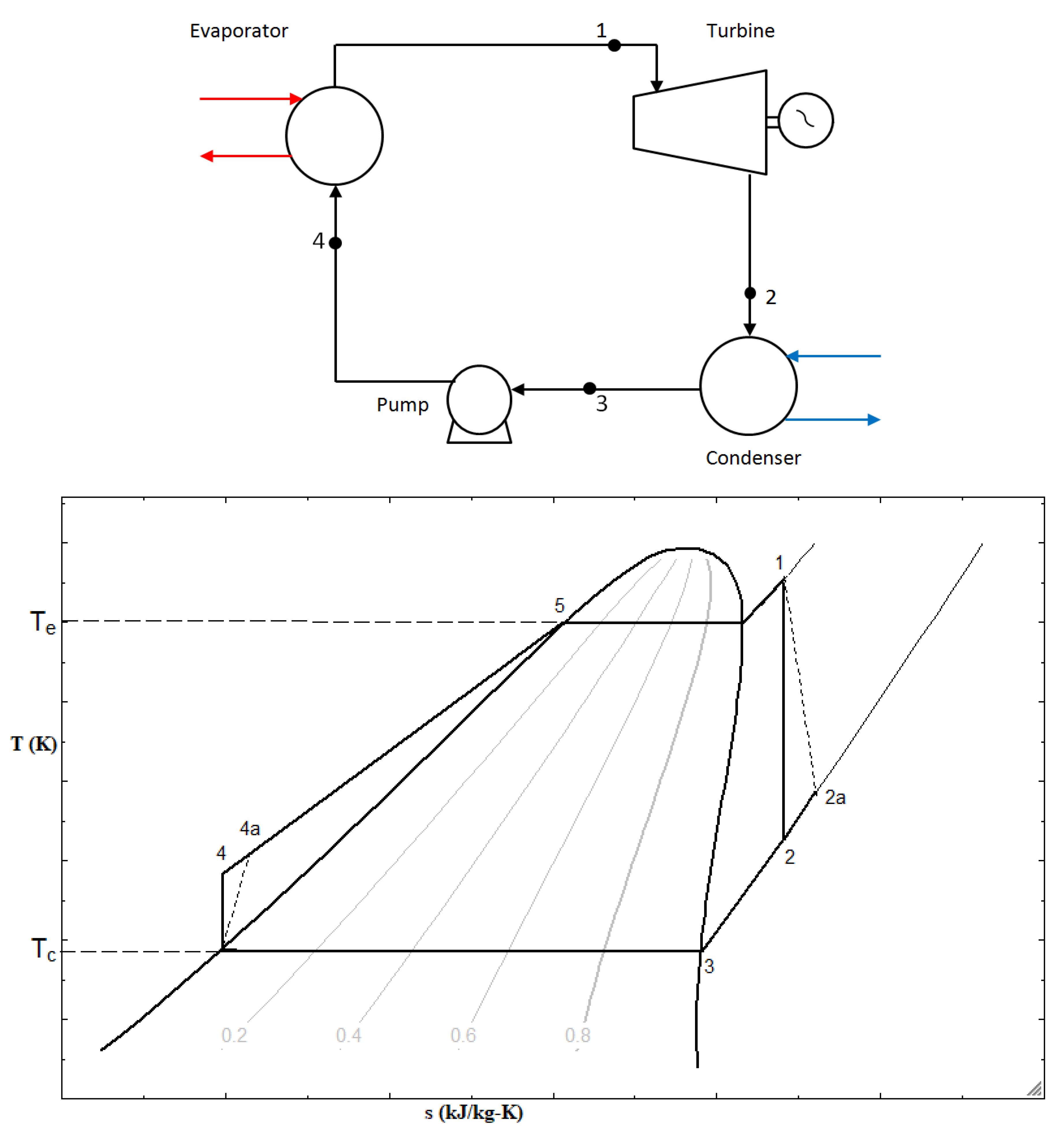

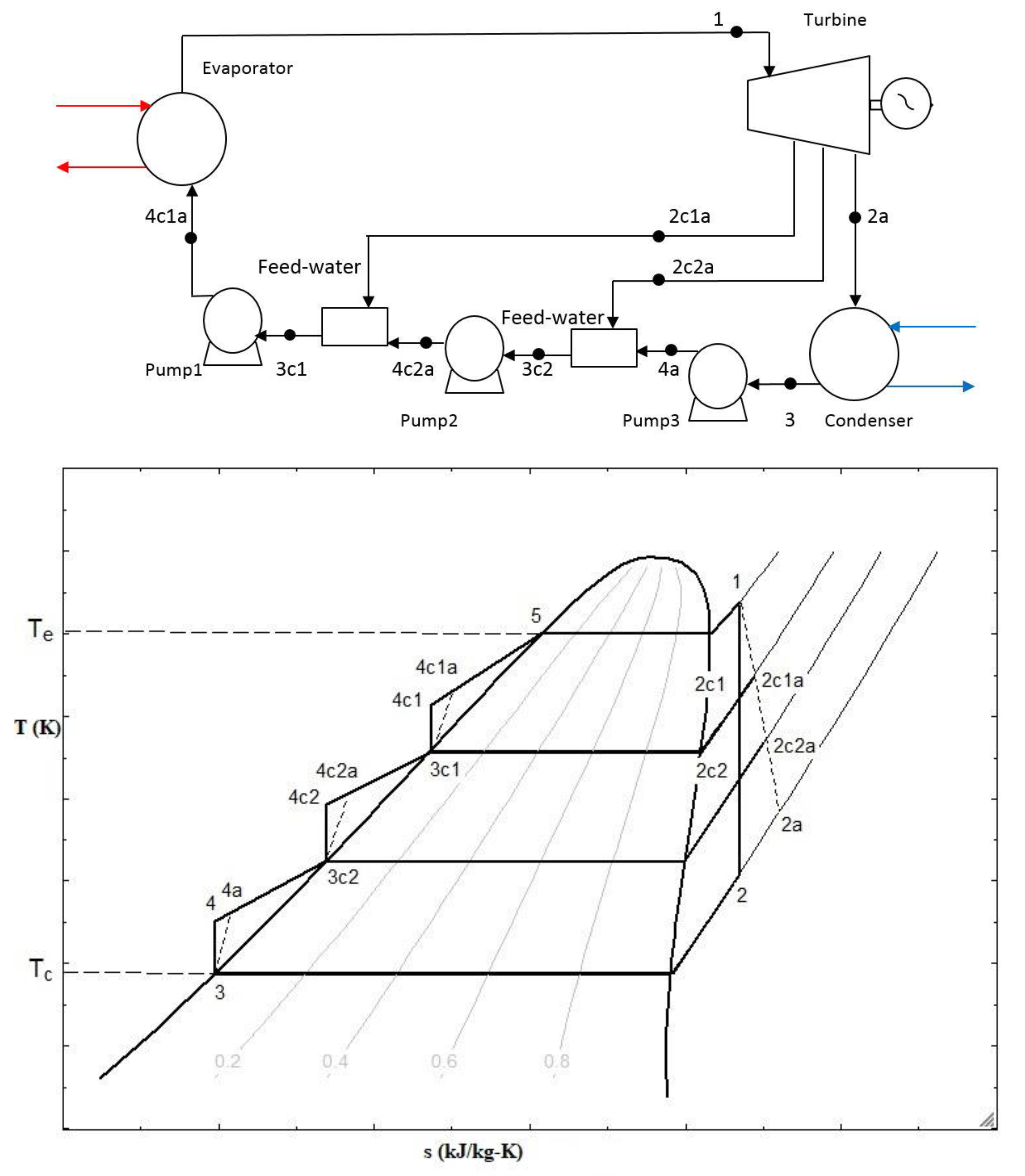
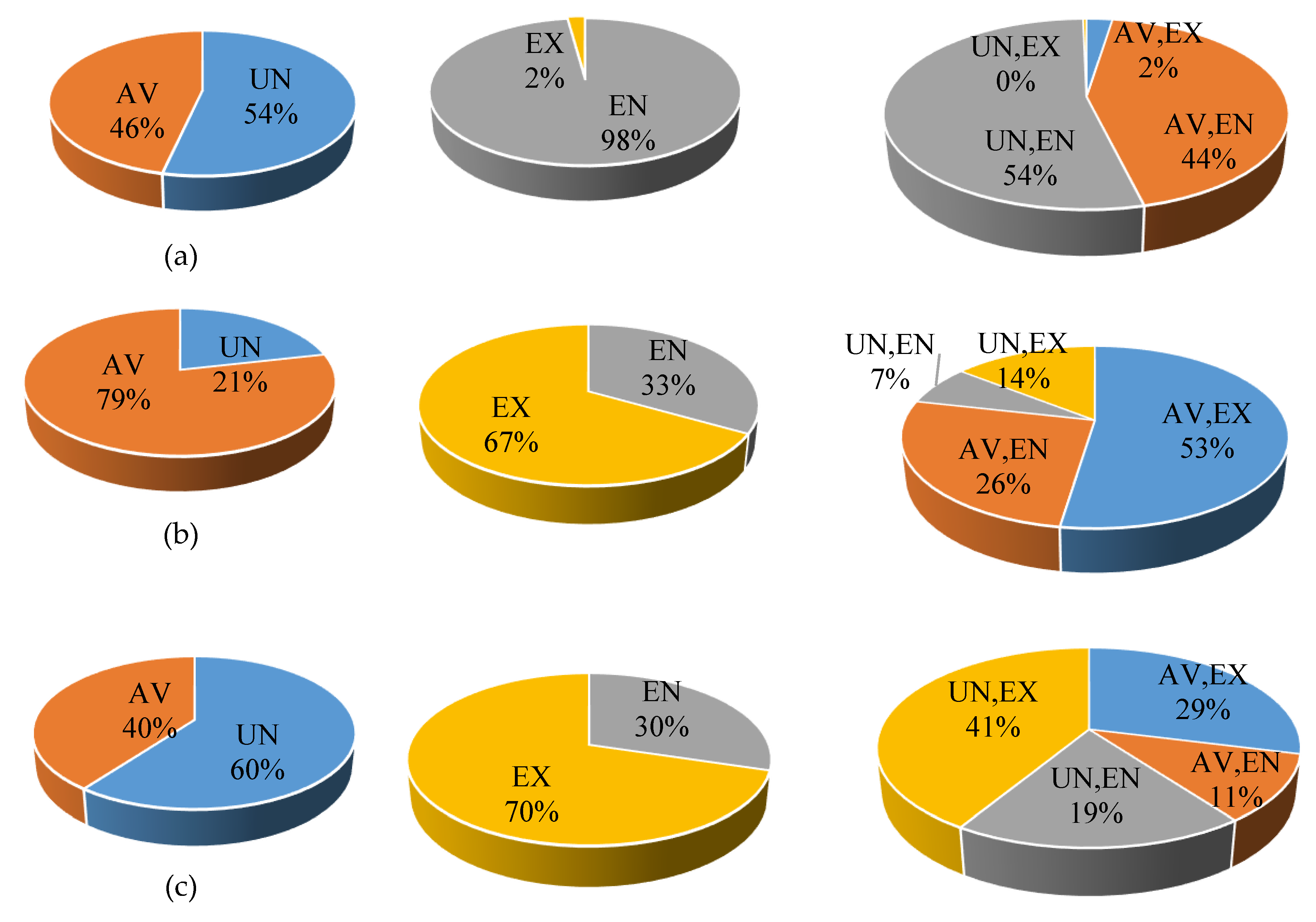

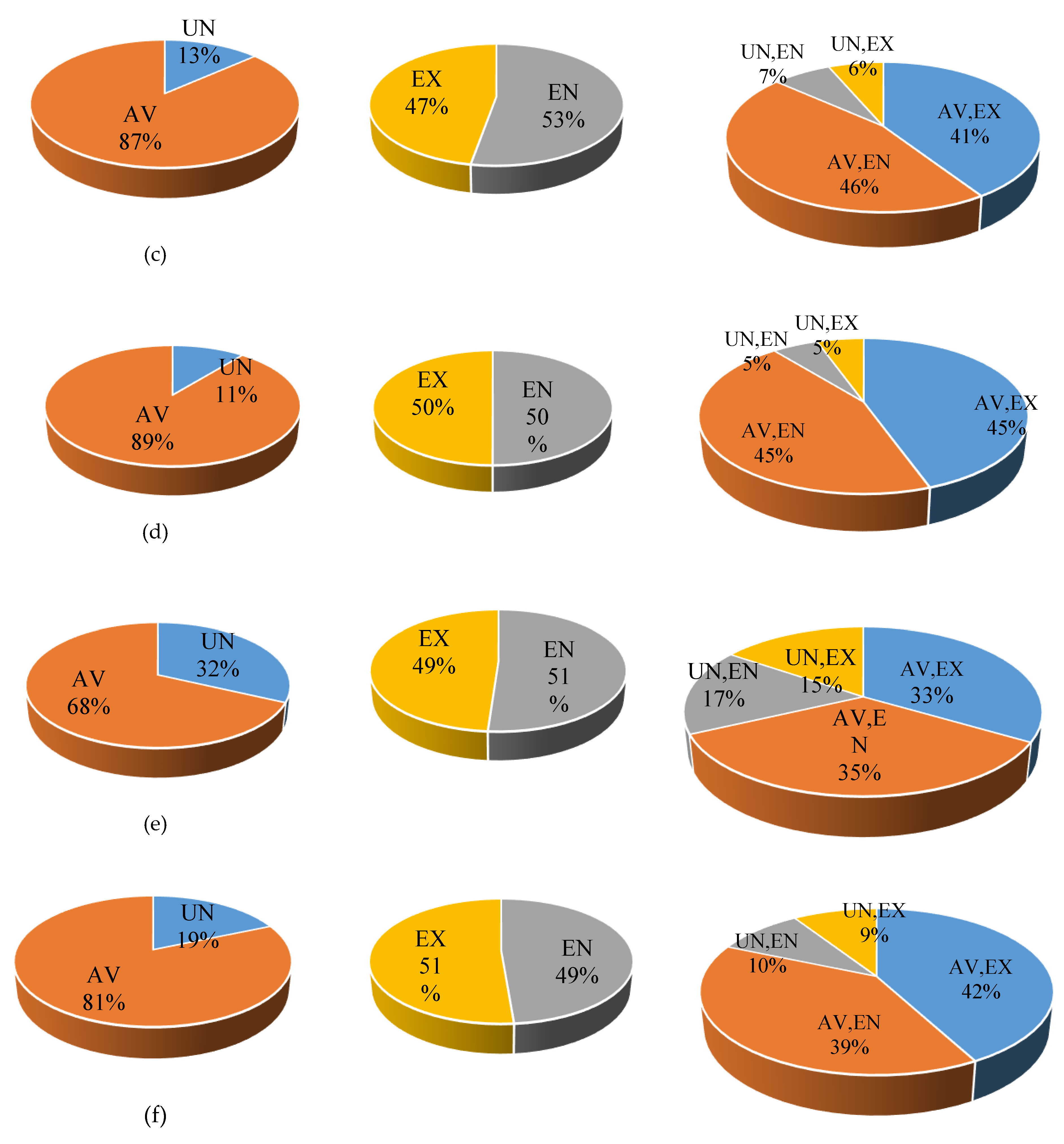
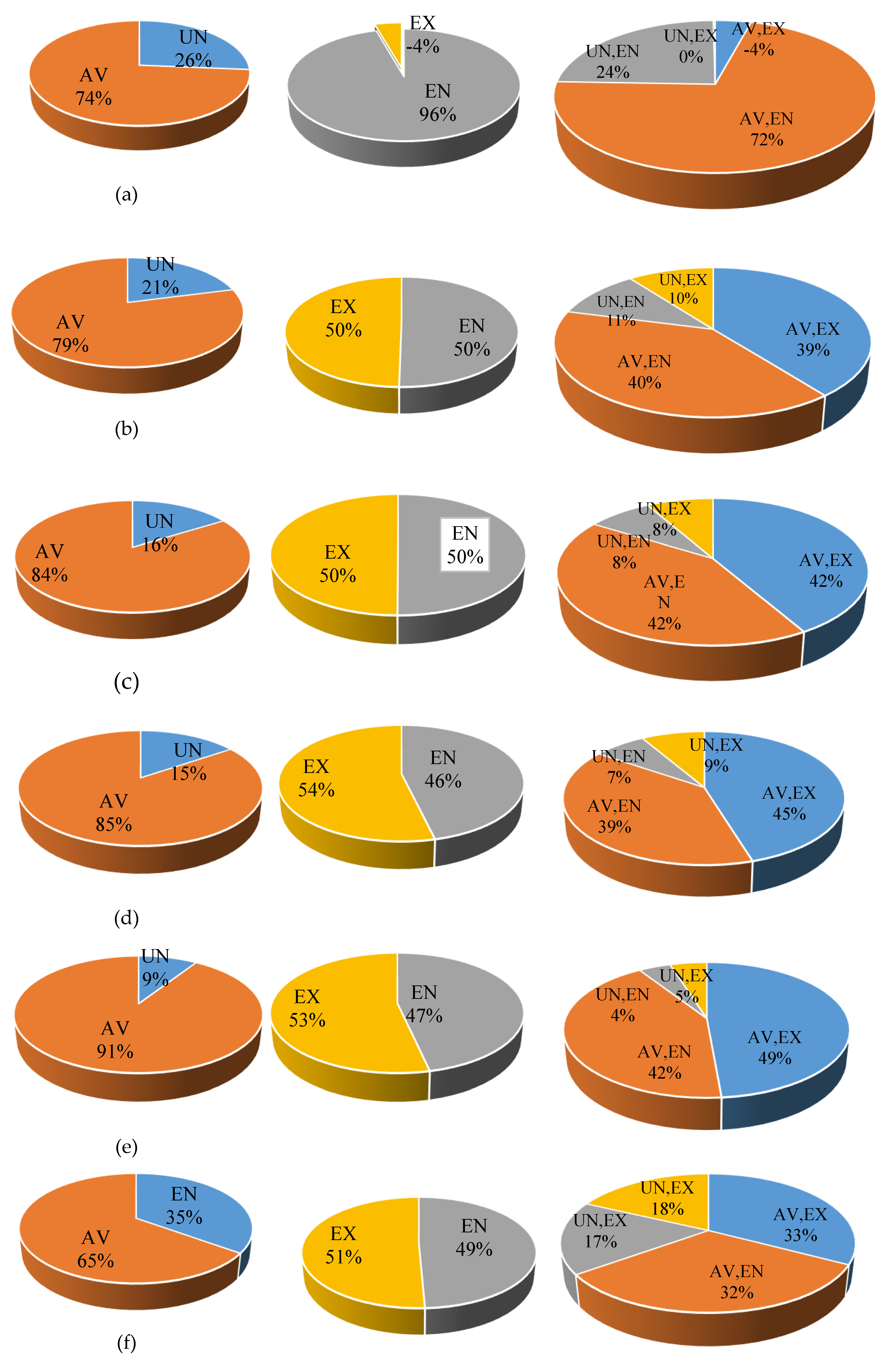

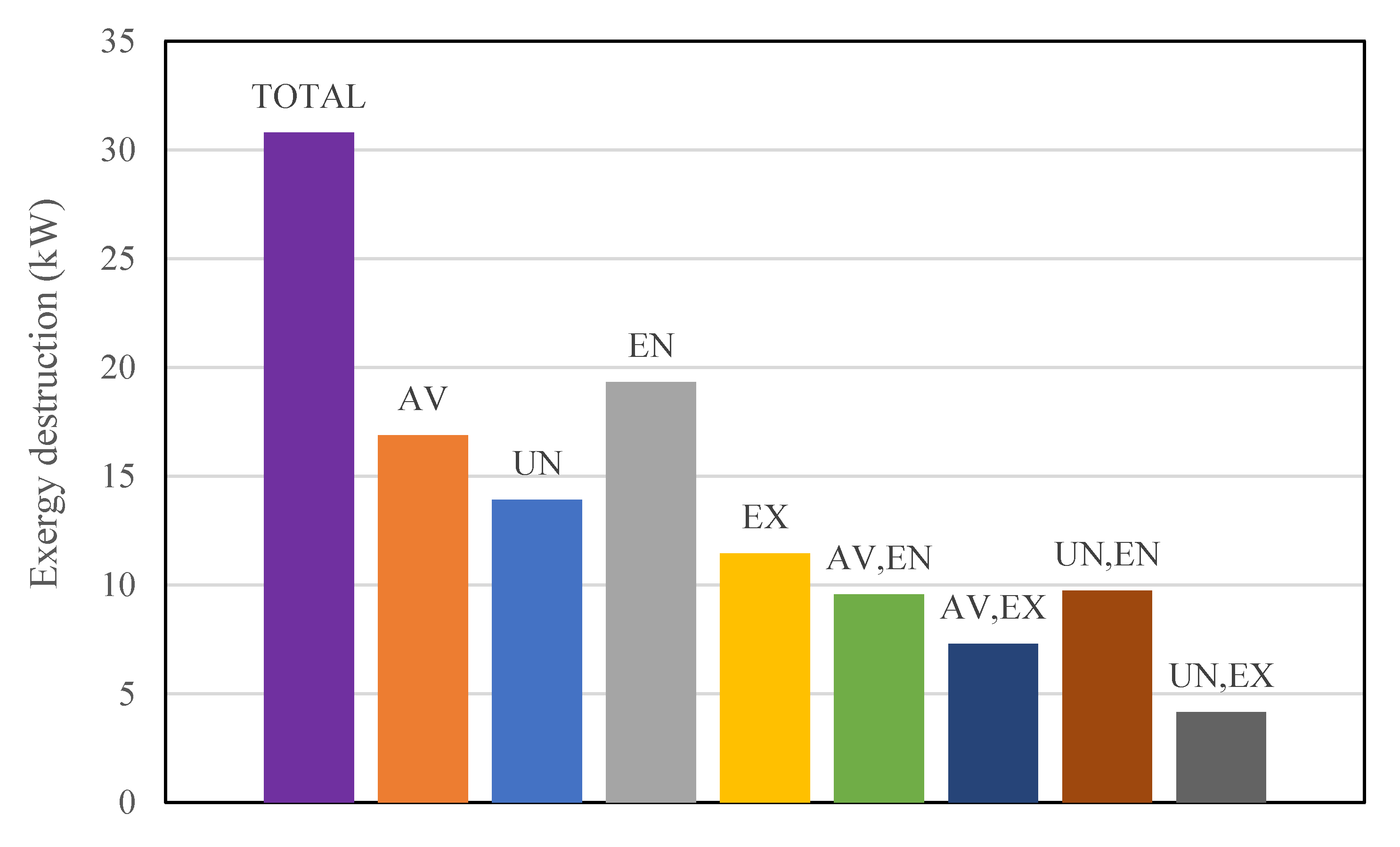
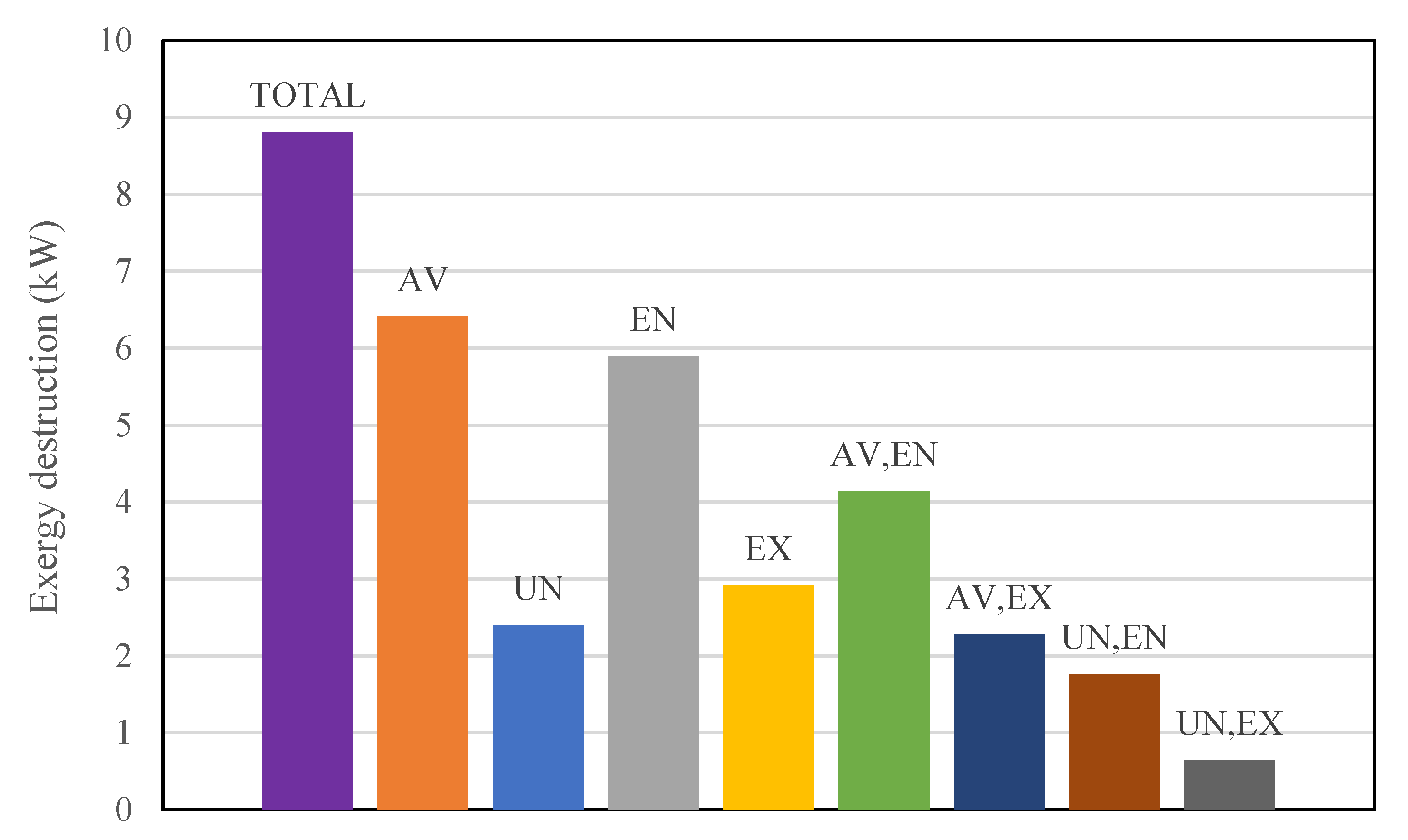
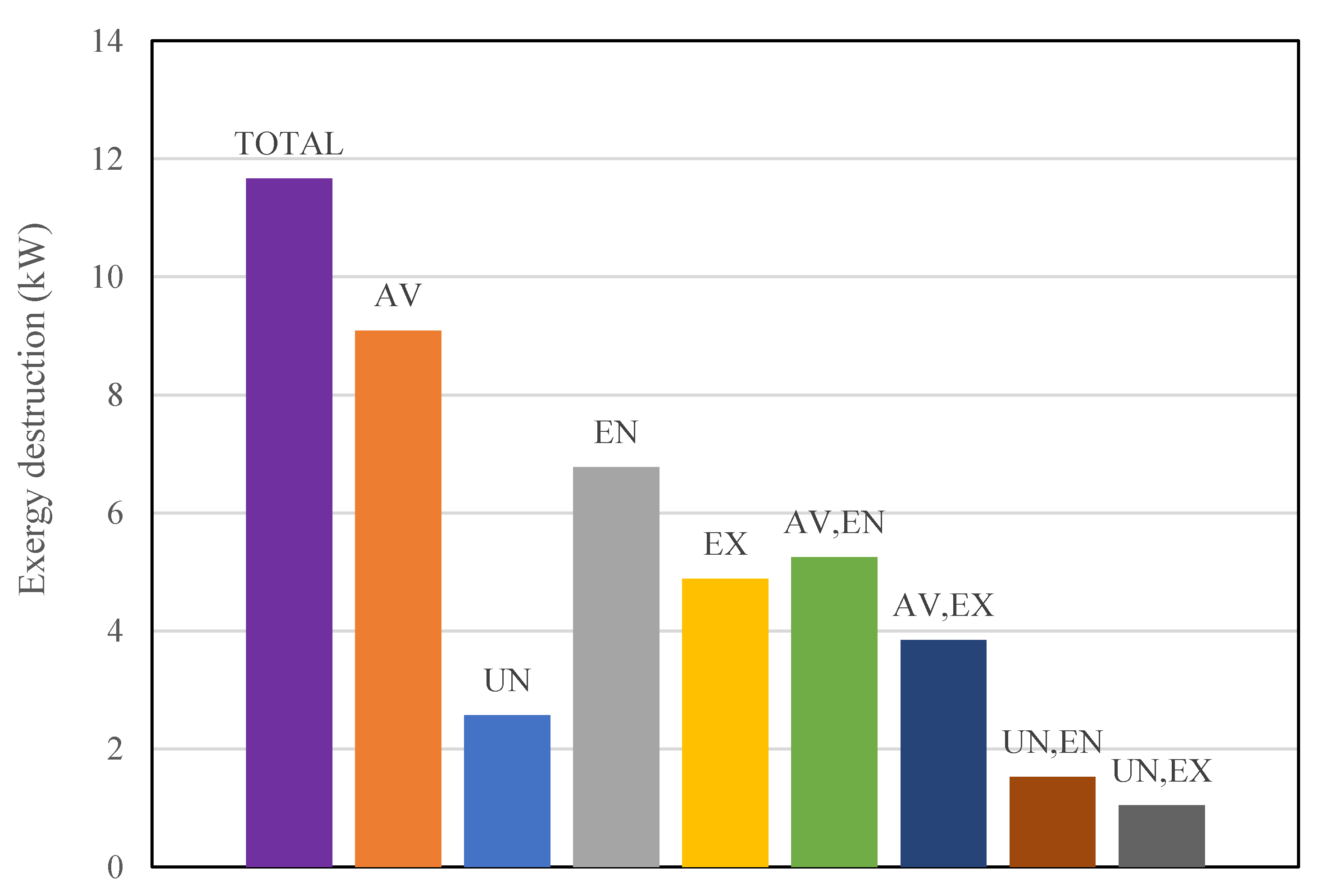
| Cycle Components | Exergy Balance Equations | ||
|---|---|---|---|
| BORC | SRORC | DRORC | |
| Evaporator | 4 + q, Eva = 1+ D, Eva | 4c1a + q, Eva = 1+ D, Eva | 4c1a + q, Eva = 1+ D, Eva |
| Turbine | 1 = w, tur + 2+ D, Tur | 1 = w, tur + 2a + 2c1a+ D, Tur | 1 = w, tur + 2a + 2c1a + 2c2a+ D, Tur |
| Condenser | 2 = q, con + 3 + D, cond | 2a = q, con + 3 + D, cond | 2a = q, con + 3 + D, cond |
| Pump | 3 + w, pump = 4+ D, pump | 3c1 + w, pump1 = 4c1a+ D, pump1 3 + w, pump2 = 4a+ D, pump2 | 3c1 + w, pump1 = 4c1a+ D, pump1 3c2 + w, pump2 = 4c2a+ D, pump2 3 + w, pump3 = 4a+ D, pump3 |
| Feed-water heater | _ | 4 + 2c1a =3c1 + D, feed-water | 4c2a + 2c1a =3c1+ D, feed-water1 4a + 2c2a =3c2+ D, feed-water2 |
| Cycle Component | Real Conditions | Unavoidable Conditions | Ideal Conditions |
|---|---|---|---|
| Evaporator | 8 °C 2% | 3 °C 1% | 0 °C 0% |
| Turbine | 0.8% | 0.95% | 1% |
| Condenser | 8 °C 2% | 3 °C 1% | 0 °C 0% |
| Pump | 0.7% | 0.9% | 1% |
| Feed-water heater | 2% | 1% | 0% |
| Parameter | Value |
|---|---|
| Temperature of heat source (K) | 420 |
| Mass flow of heat source (kg s−1) | 14 |
| Heat capacity of hot gases in constant pressure (kj kg−1 K−1) | 1.1 |
| Environmental temperature (K) | 298.15 |
| Environmental pressure (kPa) | 101.35 |
| Temperature of condensing (K) | 303.15 |
| Isentropic efficiency of turbine | 0.8 |
| Isentropic efficiency of pump | 0.7 |
| Minimum temperature difference in the evaporator (Pinch) (K) | 8 |
| Parameter | BORC Results | SRORC Results | DRORC Results | |||
|---|---|---|---|---|---|---|
| This Study | Reference [12] | This Study | Reference [12] | This Study | Reference [12] | |
| Te (K) | 401.263 | 401.6 | 407.412 | 407.7 | 407.682 | 408 |
| P3 (kPa) | 125.961 | 125.3 | 125.961 | 125.3 | 125.961 | 125.3 |
| Tout (K) | 401.930 | 401.4 | 413.312 | 413.5 | 414.104 | 414.6 |
| eη | 50.61 | 58.4 | 55.00 | 63.19 | 56.87 | 65.2 |
| ηt | 13.89 | 15.99 | 15.64 | 17.98 | 16.21 | 18.62 |
| Wp1(kW) | 1.362 | 1.502 | 0.5967 | 0.6251 | 0.496 | 0.5175 |
| Wp2(kW) | - | - | 0.138 | 0.1457 | 0.128 | 0.1396 |
| Wp3(kW) | - | - | - | - | 0.074 | 0.07804 |
| Wt (kW) | 40.003 | 43.91 | 16.845 | 17.65 | 15.418 | 16.17 |
| Wnet(kW) | 38.641 | 42.41 | 16.111 | 16.88 | 14.720 | 15.43 |
| m (kg/s) | 1.215 | 1.17 | 0.568 | 0.5212 | 0.536 | 0.4929 |
| Qe (kj/s) | 278.267 | 265.1 | 102.999 | 96.63 | 90.800 | 91.32 |
| Qc (kj/s) | 239.626 | 222.7 | 86.888 | 93.89 | 76.080 | 82.89 |
| Xc1 | - | - | 0.20309 | 0.2031 | 0.132 | 0.1323 |
| Xc2 | - | - | - | - | 0.128 | 0.129 |
| Component | ε (%) | |||||
|---|---|---|---|---|---|---|
| Evaporator | 88.95 | 74.51 | 14.44 | 83.766 | 16.233 | 46.898 |
| Turbine | 53.1 | 43.68 | 9.42 | 82.259 | 17.740 | 30.594 |
| Pump | 1.538 | 1.538 | 0 | 100 | 0 | 0 |
| Condenser | 22.94 | 16.01 | 6.93 | 69.790 | 30.209 | 22.507 |
| Component | ε (%) | |||||
|---|---|---|---|---|---|---|
| Evaporator | 32.63 | 30.16 | 2.47 | 92.430 | 7.569 | 28.036 |
| Turbine | 21.5 | 17.64 | 3.86 | 82.046 | 17.953 | 43.813 |
| Pump1 | 0.648 | 0.148 | 0.499 | 22.962 | 77.037 | 5.666 |
| Pump2 | 0.151 | 0.015 | 0.135 | 10.257 | 89.742 | 1.541 |
| Feed-water heater | 4.778 | 3.84 | 0.938 | 80.368 | 19.631 | 10.647 |
| Condenser | 7.887 | 6.98 | 0.907 | 88.500 | 11.499 | 10.295 |
| Component | ε (%) | |||||
|---|---|---|---|---|---|---|
| Evaporator | 28.67 | 26.91 | 1.76 | 93.861 | 6.138 | 15.087 |
| Turbine | 24.39 | 16.06 | 8.33 | 65.846 | 34.153 | 71.408 |
| Pump1 | 0.536 | 0.138 | 0.397 | 25.857 | 74.142 | 3.409 |
| Pump2 | 0.145 | 0.028 | 0.116 | 19.545 | 80.454 | 1.001 |
| Pump 3 | 0.079 | 0.008 | 0.0717 | 10.232 | 89.767 | 0.615 |
| Feed-water heater1 | 3.274 | 3.044 | 0.23 | 92.974 | 7.025 | 1.971 |
| Feed-water heater2 | 2.421 | 1.984 | 0.437 | 81.949 | 18.050 | 3.746 |
| Condenser | 6.867 | 6.545 | 0.322 | 95.310 | 4.689 | 2.760 |
| Component | |||||||||
|---|---|---|---|---|---|---|---|---|---|
| Evaporator | 14.44 | 7.725 | 6.714 | 14.13 | 0.31 | 0.357 | 6.356 | −0.047 | 7.773 |
| Turbine | 9.42 | 2.0194 | 7.400 | 3.135 | 6.285 | 4.935 | 2.464 | 1.349 | 0.670 |
| Pump | 0 | 0 | 0 | 0 | 0 | 0 | 0 | 0 | 0 |
| Condenser | 6.93 | 4.168 | 2.761 | 2.06 | 4.87 | 2.005 | 0.756 | 2.864 | 1.303 |
| Component | |||||||||
|---|---|---|---|---|---|---|---|---|---|
| Evaporator | 2.47 | 1.027 | 1.442 | 2.561 | −0.091 | −0.084 | 1.527 | −0.006 | 1.033 |
| Turbine | 3.86 | 0.824 | 3.035 | 2.083 | 1.777 | 1.397 | 1.637 | 0.379 | 0.445 |
| Pump 1 | 0.499 | 0.067 | 0.431 | 0.263 | 0.235 | 0.203 | 0.228 | 0.032 | 0.034 |
| Pump 2 | 0.135 | 0.014 | 0.121 | 0.067 | 0.067 | 0.060 | 0.060 | 0.007 | 0.007 |
| Feed-water heater | 0.938 | 0.299 | 0.638 | 0.479 | 0.458 | 0.313 | 0.324 | 0.144 | 0.155 |
| Condenser | 0.907 | 0.168 | 0.738 | 0.441 | 0.465 | 0.382 | 0.356 | 0.082 | 0.085 |
| Component | |||||||||
|---|---|---|---|---|---|---|---|---|---|
| Evaporator | 1.76 | 0.463 | 1.296 | 1.845 | −0.085 | −0.080 | 1.377 | −0.004 | 0.467 |
| Turbine | 8.33 | 1.742 | 6.587 | 4.188 | 4.142 | 3.284 | 3.303 | 0.857 | 0.884 |
| Pump 1 | 0.397 | 0.064 | 0.333 | 0.199 | 0.198 | 0.165 | 0.167 | 0.032 | 0.031 |
| Pump 2 | 0.116 | 0.018 | 0.098 | 0.054 | 0.062 | 0.053 | 0.045 | 0.009 | 0.008 |
| Pump 3 | 0.071 | 0.006 | 0.065 | 0.033 | 0.038 | 0.035 | 0.030 | 0.003 | 0.003 |
| Feed-water heater 1 | 0.23 | 0.080 | 0.149 | 0.113 | 0.116 | 0.075 | 0.074 | 0.041 | 0.039 |
| Feed-water heater 2 | 0.437 | 0.124 | 0.312 | 0.205 | 0.231 | 0.167 | 0.146 | 0.064 | 0.059 |
| Condenser | 0.322 | 0.072 | 0.249 | 0.138 | 0.183 | 0.145 | 0.104 | 0.038 | 0.034 |
© 2020 by the authors. Licensee MDPI, Basel, Switzerland. This article is an open access article distributed under the terms and conditions of the Creative Commons Attribution (CC BY) license (http://creativecommons.org/licenses/by/4.0/).
Share and Cite
Yousefizadeh Dibazar, S.; Salehi, G.; Davarpanah, A. Comparison of Exergy and Advanced Exergy Analysis in Three Different Organic Rankine Cycles. Processes 2020, 8, 586. https://doi.org/10.3390/pr8050586
Yousefizadeh Dibazar S, Salehi G, Davarpanah A. Comparison of Exergy and Advanced Exergy Analysis in Three Different Organic Rankine Cycles. Processes. 2020; 8(5):586. https://doi.org/10.3390/pr8050586
Chicago/Turabian StyleYousefizadeh Dibazar, Shahab, Gholamreza Salehi, and Afshin Davarpanah. 2020. "Comparison of Exergy and Advanced Exergy Analysis in Three Different Organic Rankine Cycles" Processes 8, no. 5: 586. https://doi.org/10.3390/pr8050586
APA StyleYousefizadeh Dibazar, S., Salehi, G., & Davarpanah, A. (2020). Comparison of Exergy and Advanced Exergy Analysis in Three Different Organic Rankine Cycles. Processes, 8(5), 586. https://doi.org/10.3390/pr8050586






